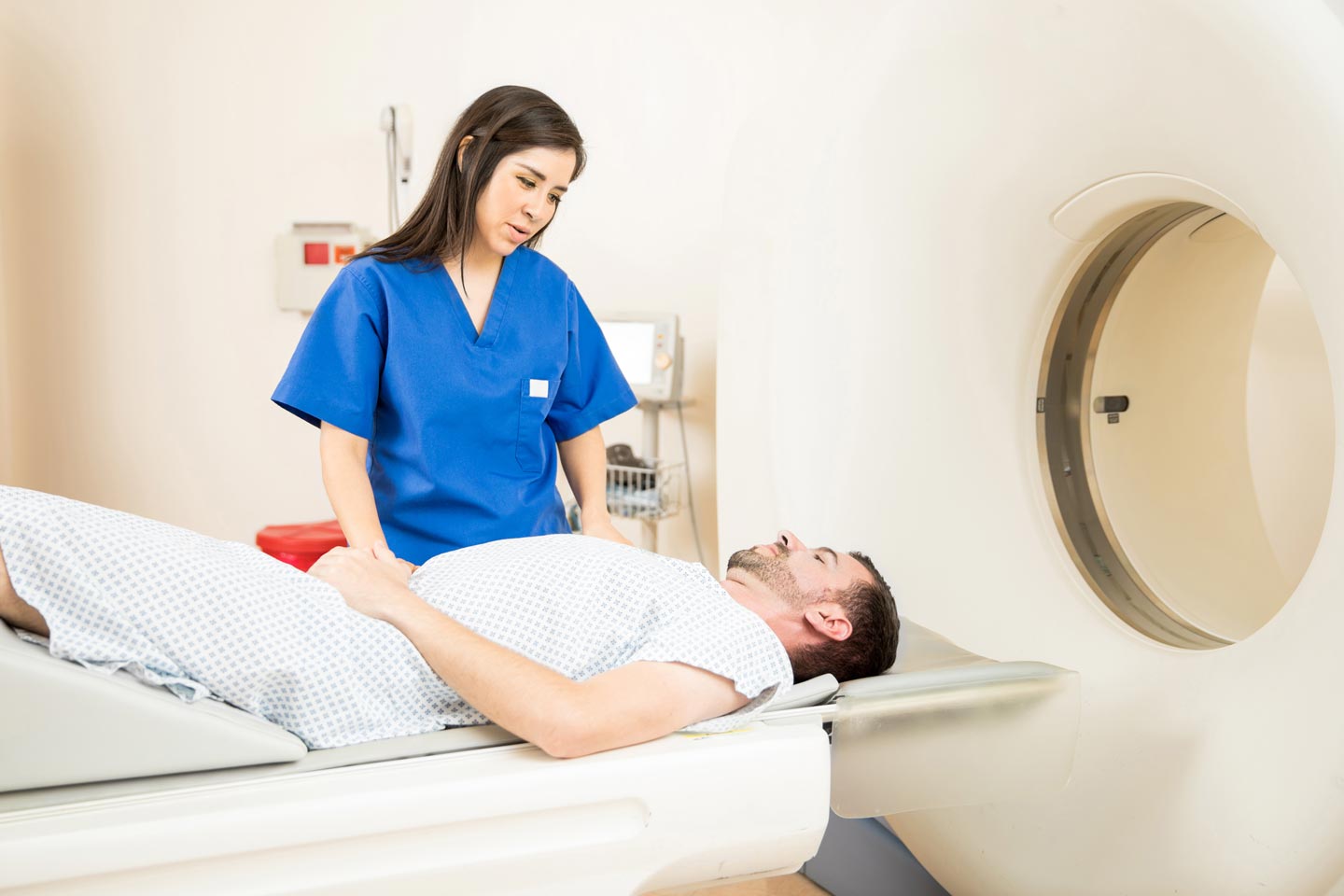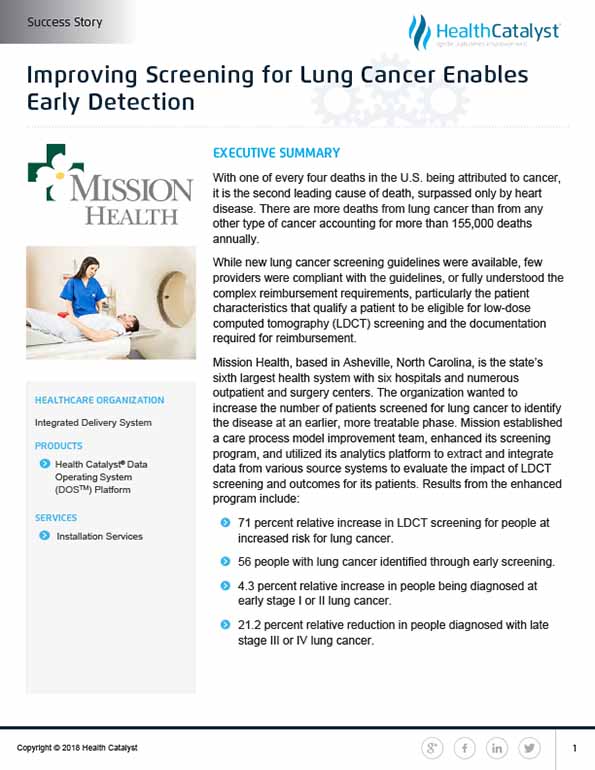There are more deaths from lung cancer than from any other type of cancer—more than 155,000 deaths annually. Learn how Mission Health utilized its analytics platform to improve the screening and outcomes for patients with lung cancer
With one of every four deaths in the U.S. being attributed to cancer, it is the second leading cause of death, surpassed only by heart disease. There are more deaths from lung cancer than from any other type of cancer accounting for more than 155,000 deaths annually.
While new lung cancer screening guidelines were available, few providers were compliant with the guidelines, or fully understood the complex reimbursement requirements, particularly the patient characteristics that qualify a patient to be eligible for low-dose computed tomography (LDCT) screening and the documentation required for reimbursement.
Mission Health, based in Asheville, North Carolina, is the state’s sixth largest health system with six hospitals and numerous outpatient and surgery centers. The organization wanted to increase the number of patients screened for lung cancer to identify the disease at an earlier, more treatable phase. Mission established a care process model improvement team, enhanced its screening program, and utilized its analytics platform to extract and integrate data from various source systems to evaluate the impact of LDCT screening and outcomes for its patients.
One of every four deaths in the U.S. can be attributed to cancer, making it the second leading cause of death. Lung cancer deaths are more prevalent than those from any other type of cancer—more than 155,000 people die annually, more than with colon, breast, and prostate cancers combined.1,2
Labeled as a “smoker’s disease,” lung cancer is highly stigmatized. The low survival rate, late onset of symptoms, and lack of knowledge about lung cancer have further contributed to limited conversations between patients and their providers about lung cancer, at times, delaying diagnosis and treatment.2 Historically, there have been limited clinical guidelines for lung cancer screening.2
Mission Health, based in Asheville, North Carolina, is the state’s sixth largest health system with six hospitals, numerous outpatient and surgery centers, and is the region’s only dedicated Level II trauma center. Mission’s BIG(GER) Aim drives its daily work to improve outcomes by helping every person to achieve their desired outcome, first without harm, also without waste and always with an exceptional experience for each person, family, and team member. As part of its chronic care and adult preventative care activities, Mission made a goal to improve the number of patients screened for lung cancer.
Recent evidence from the National Lung Screening Trial demonstrated that early lung cancer screening for people at risk for developing lung cancer, using LDCT, increases the detection of lung cancer, facilitating early treatment and reducing mortality.3 Based on this evidence, the Centers for Medicare and Medicaid Services began reimbursing for preventative lung cancer screening counseling, a shared decision-making visit, and annual screening for lung cancer using LDCT for patients who meet specific criteria.4
While new lung cancer screening guidelines were available, few providers were deeply familiar with them or fully understood the complex reimbursement requirements, particularly the patient characteristics that qualify a patient to be eligible for LDCT screening and the documentation required for reimbursement.
When an abnormal test resulted from an LDCT screening, Mission lacked a clear pathway to support providers in ensuring the patient received the appropriate follow-up imaging and referral to a specialist in a timely manner, including longitudinal follow up for likely benign disease.
To ensure widespread adoption of the lung cancer screening clinical guidelines, facilitating early diagnosis and treatment of lung cancer, Mission convened an lung cancer prevention improvement team to develop and implement the processes for this type of screening. Members include radiologists, primary care providers, pulmonologists, oncologists, and thoracic surgeons. The improvement team also includes representatives from nursing, quality improvement, information technology, and analytics.
To be most effective in implementing lung cancer screening, Mission focused its early improvement efforts on its network of primary care employed practices. The health system developed and provided an educational program for primary care providers more generally for adult prevention, including outlining the current lung cancer screening recommendations and the specific criteria patients must meet to be eligible for screening using LDCT. Patients who meet the following criteria are eligible for lung cancer using LDCT:
To facilitate screening, an alert was created within the EMR to consistently inform providers to consider lung cancer screening annually for all smokers between the ages of 55-77. This meaningful decision support allows providers to generate a work list of patients who meet criteria to proactively manage appropriate screening. Prior to the LDCT, providers must attest that they explained the risk and benefits to the patient and document that the patient wishes to proceed with testing.
The Mission lung cancer prevention improvement streamlined the process for ordering the LDCT and follow-up, building comprehensive standard order sets in the EMR that address all phases of the screening. The order sets are aligned with provider workflow and contain all of the elements required to complete the initial screening, follow-up based upon the results of the initial screening, and the documentation necessary for appropriate reimbursement. Providers can easily document the:
If the LDCT results are positive for a possible lung cancer diagnosis, the standard order sets contain the follow-up activities, including:
By streamlining the follow-up processes, communication between providers is improved and helps ensure additional diagnostics are completed and available for the initial visit with the specialist. The nurse navigators work closely with patients and are available to help the provider guide the patient through the screening process.
Mission’s radiology center obtained certification from the American College of Radiology (ACR) as an ACR Designated Lung Cancer Screening Center to ensure patients receive the highest level of image quality and safety. This certification confirmed that the facility meets the requirements for equipment, medical personnel, and quality assurance.
Mission uses the Health Catalyst® Data Operating System (DOS™) Platform to extract and integrate data from various source systems and gather them into the data warehouse. The organization uses the analytics platform to evaluate the impact of LDCT screening and outcomes for its patients.
On a monthly basis, improvement leaders review performance data. The actionable data from the analytics platform supports the team in providing timely feedback to providers regarding participation in the lung cancer screening program and opportunities for improvement. Mission closely monitors the time from screening to the time of treatment, and shares this data with the improvement team and providers, using this information to further reduce the time between screening and treatment.
Mission has significantly increased its use of LDCT screening for patients at an elevated risk of lung cancer, improving early detection for patients with this disease. Results include:
“The growth of the program and the adoption of lung cancer screening has been satisfying. We now routinely identify stage I lung cancer, which prior to the screening program rarely happened.”
– John Ende, MD, Radiologist
Mission will continue to encourage widespread adoption and increased lung cancer screening. The organization is also continuing its efforts to prevent lung cancer by reducing the stigma associated with lung cancer and promoting smoking cessation, and has incorporated lung cancer screening into its quality incentive program for providers.




